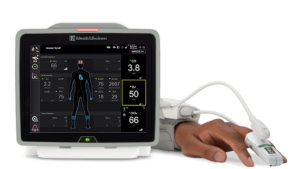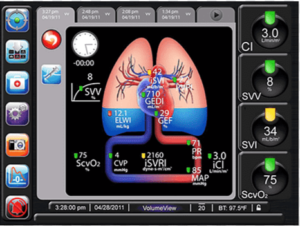Cardiac output (CO) monitors are medical devices used to measure the amount of blood the heart pumps per minute. This measurement is critical for assessing the cardiac function of patients, particularly in critical care settings, during surgery, and in patients with heart conditions. Here’s a detailed overview of cardiac output monitors:

- Importance of Cardiac Output Monitoring
Cardiac Output (CO):
- Definition: The volume of blood the heart pumps per minute.
- Formula: CO = Heart Rate (HR) × Stroke Volume (SV), where Stroke Volume is the amount of blood ejected by the left ventricle in one contraction.
Clinical Significance:
- Provides insights into cardiac function and systemic circulation.
- Helps guide fluid management, drug therapy, and overall cardiovascular support.
- Essential in managing critically ill patients, those undergoing major surgery, and patients with heart failure.
- Methods of Cardiac Output Measurement
Invasive Techniques:
- Pulmonary Artery Catheterization (PAC):
- Also known as Swan-Ganz catheter.

- Measures CO using the thermodilution technique.
- Involves inserting a catheter into the pulmonary artery.
- Also known as Swan-Ganz catheter.
- Arterial Pulse Contour Analysis:
- Uses an arterial line to measure the pressure waveform.
- Examples: PiCCO (Pulse index Continuous Cardiac Output), LiDCO.
Less Invasive Techniques:
- Transesophageal Echocardiography (TEE):
- Uses an ultrasound probe inserted into the esophagus to visualize the heart and measure CO.
- Doppler Ultrasound:
- Measures blood flow velocity in the aorta or pulmonary artery.
- Examples: Esophageal Doppler, Transthoracic Doppler.
Non-Invasive Techniques:
- Bioimpedance and Bioreactance:
- Measures changes in electrical conductivity of the thorax.
- Examples: NICOM (Non-invasive Cardiac Output Monitoring).
- Partial CO2 Rebreathing:
- Estimates CO based on changes in CO2 levels during rebreathing.
- Example: NICO (Non-Invasive Cardiac Output).
- Technologies and Devices
Key Devices and Systems:
- Swan-Ganz Catheter: Widely used in critical care for accurate CO measurement through thermodilution.
- PiCCO System: Combines pulse contour analysis and transpulmonary thermodilution for CO measurement.
- LiDCO System: Uses lithium dilution and pulse contour analysis.
- NICOM: Utilizes bioreactance technology for non-invasive CO measurement.
- FloTrac/Vigileo System: Monitors CO using arterial pressure waveform analysis.
- Edwards EV1000: Provides advanced hemodynamic monitoring including CO, stroke volume variation, and systemic vascular resistance.
- Clinical Applications
- Critical Care: Continuous monitoring of CO in ICU patients to manage fluid therapy, inotropic support, and vasopressor therapy.
- Surgery: Monitoring during major surgeries to guide anesthetic and fluid management.
- Heart Failure Management: Assessing the effectiveness of treatments and managing chronic heart failure.
- Emergency Medicine: Quick assessment in shock, trauma, and acute heart conditions.

- Advantages and Limitations
Advantages:
- Provides real-time data on cardiac function.
- Helps in early detection of hemodynamic instability.
- Guides therapeutic interventions for optimal patient management.
Limitations:
- Invasive methods carry risks of infection, bleeding, and vascular injury.
- Non-invasive methods may be less accurate in certain clinical situations.
- Equipment costs and need for specialized training.
- Future Trends
- Development of more accurate and less invasive monitoring technologies.
- Integration with other hemodynamic parameters and smart monitoring systems.
- Advances in wearable technology for continuous cardiac monitoring outside clinical settings.
Cardiac output monitors are essential tools in modern medicine, providing critical information that helps save lives and improve patient outcomes in various clinical scenarios
